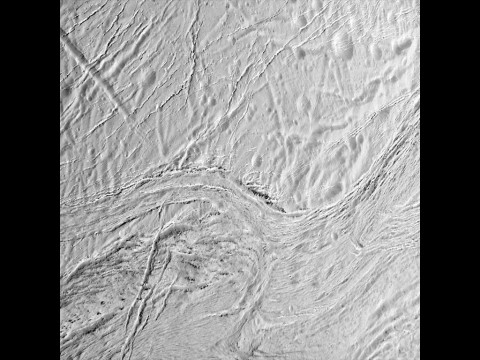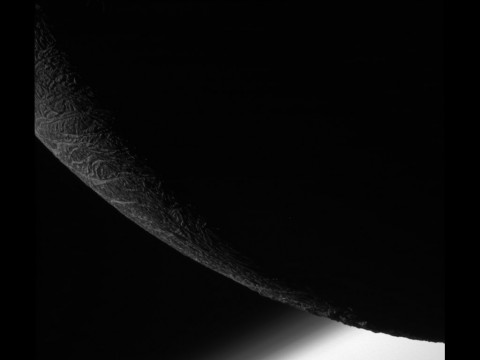Written by Preston Dyches
NASA’s Jet Propulsion Laboratory
 Pasadena, CA – NASA’s Cassini spacecraft has begun transmitting data and images from the mission’s final close flyby of Saturn’s active moon Enceladus. Cassini passed Enceladus at a distance of 3,106 miles (4,999 kilometers) on Saturday, December 19th, at 9:49am PST (11:49am CST).
Pasadena, CA – NASA’s Cassini spacecraft has begun transmitting data and images from the mission’s final close flyby of Saturn’s active moon Enceladus. Cassini passed Enceladus at a distance of 3,106 miles (4,999 kilometers) on Saturday, December 19th, at 9:49am PST (11:49am CST).
“This final Enceladus flyby elicits feelings of both sadness and triumph,” said Earl Maize, Cassini project manager at JPL. “While we’re sad to have the close flybys behind us, we’ve placed the capstone on an incredible decade of investigating one of the most intriguing bodies in the solar system.”

This was the 22nd Enceladus encounter of Cassini’s mission. The spacecraft’s discovery of geologic activity there, not long after arriving at Saturn, prompted changes to the mission’s flight plan to maximize the number and quality of flybys of the icy moon.
“We bid a poignant goodbye to our close views of this amazing icy world,” said Linda Spilker, the mission’s project scientist at NASA’s Jet Propulsion Laboratory in Pasadena, California. “Cassini has made so many breathtaking discoveries about Enceladus, yet so much more remains to be done to answer that pivotal question, ‘Does this tiny ocean world harbor life?'”
After revealing Enceladus’ surprising geologic activity in 2005, Cassini made a series of discoveries about the material gushing from warm fractures near its south pole. Scientists announced strong evidence for a regional subsurface sea in 2014, revising their understanding in 2015 to confirm that the moon hosts a global ocean beneath its icy crust.
In addition to the processed images, unprocessed, or “raw,” images appear on the Cassini mission website at:
http://saturn.jpl.nasa.gov/mission/flybys/enceladus20151219/
 Additional information and multimedia products for Cassini’s final Enceladus flybys are available at:
Additional information and multimedia products for Cassini’s final Enceladus flybys are available at:
http://solarsystem.nasa.gov/finalflybys
The Cassini-Huygens mission is a cooperative project of NASA, ESA (European Space Agency) and the Italian Space Agency. NASA’s Jet Propulsion Laboratory in Pasadena, California, manages the mission for the agency’s Science Mission Directorate in Washington.
The Cassini imaging operations center is based at the Space Science Institute in Boulder, Colorado.
For more information about Cassini, visit:
http://www.nasa.gov/cassini
http://saturn.jpl.nasa.gov




